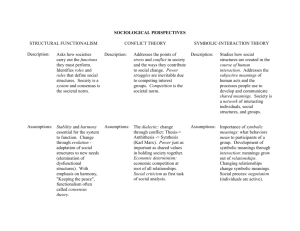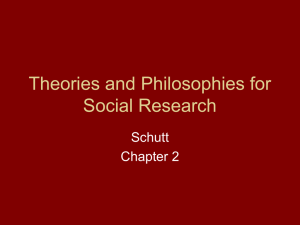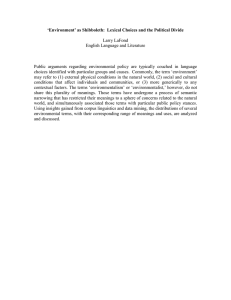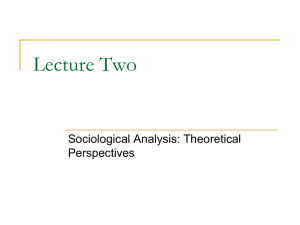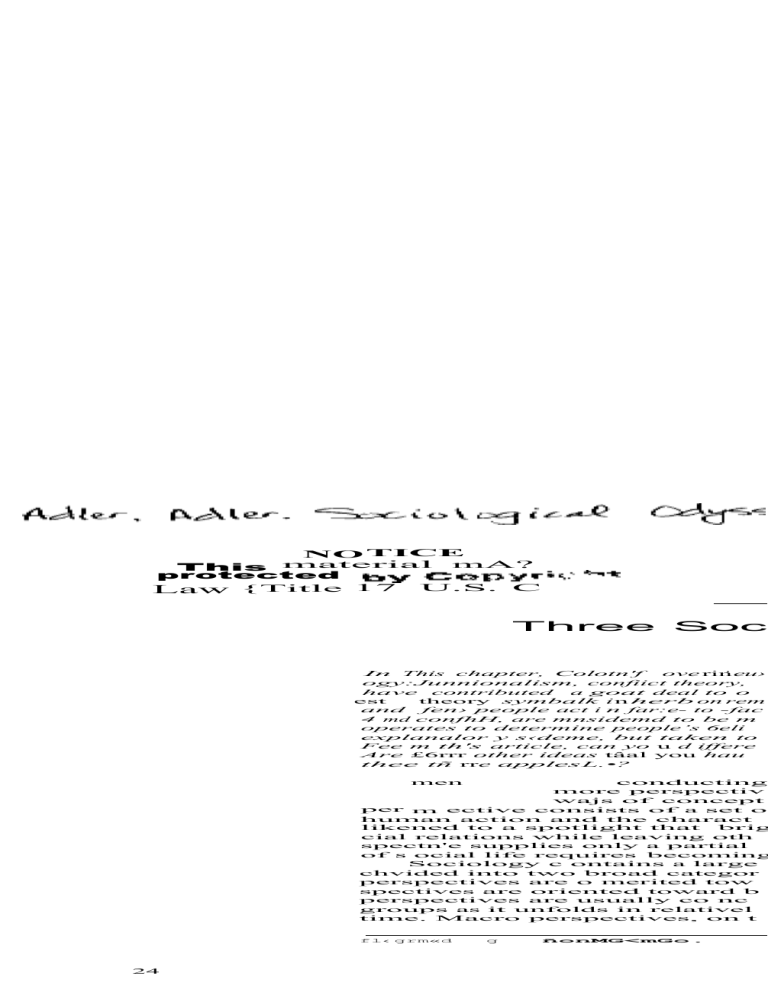
NO TICE
mA?
This material
protected
U.S. C
Law {Title 17
Three
Soc
In This chapter, Colotn'f
ove rin
’ eu›
ogy:Junnionalism, confiict theory,
have
contributed
a goat deal to o
est
theory
symbalk i n herb on rem
and
fen› people act i n far:e- to -fac
4 md confhH, are mnsidemd to be m
operates to determine people’s 6eli
explanalor y s‹deme, but taken to
Fee m th's article, can yo u d iffere
Are £6rrr other ideas tâal you hau
thee tñ rre apples L.•?
men
conducting
more perspectiv
wajs of concept
per m ective consists of a set o
human action and the charact
likened to a spotlight that
brig
cial relations while leaving oth
spectn'e supplies only a partial
of s ocial life requires becoming
Sociology c ontains a large
chvided into two broad categor
perspectives are o merited tow
spectives are oriented toward b
perspectives are usually co nc
groups as it unfolds in relativel
time. Macro perspectives, on t
fl‹grm«d
24
g
ñonMG<mGo.
ARTICLE
4
THRE£ SOCIOLOGICA
vñduals and small groups, but institutio us, e nt
system—and on how these entities emerge, mai
decades, centuries, and rrullennia. The followin
spectk'e (symbolic inieractionism) and tu'o mac
the conoict
approach).
SY BE B O L IC
IN T E R A
Symbolic interactionisrr 's intellectual roots resi
traditio n develop ed
by
such
prominent, ear
thinkers as John Dewey,Wil1iarn James, George
The sociological implications of pragmatism w
tive sociologists, including Robert
Park, W
I.
Hughes, and Erving Go8inan, who taught or stu
between 1910 and 1960. Because it originated
bolic interactiorñw is sometimes referred to as
Symbolic interactionism is based o n five
human beings act in terms of the meanings th
ronment. (Interactionists define the term objec
things, evrnu, symbols, actions, and other peop
ferent terminology to make the same point,
conduct is powerfiilly in0uenc ed i›y• their defini
tion can b* clarified by contrasting it to a rudim
vanced by a psychological perspective known
approach characterizes conduct as a response
that human behavior resembles a series of stimu
stimulus
Rejecting
the
interactionists
fore they
act:
stimulus
>
resporise.
notion
tbat
individuals
respond
insist that people interpret, or as
interpretation
Athletes’ reactions to coaches’ criticimls, for ins
thy' interpret that criticism as a construcnve att
malicious attack on their character.
Even when a definioon of th* situation is
a p‹r.ventral
effect on behavior. As Hi
I. Thomas
rral is real in its consequences.” Marry adults, fo
filled with potenoal danger, and believe
that th
to sadistic strangers dispensing drug-tainted
blades. The belief that such ace of Halloween k
urban legend with virtually no factual basis (Be
less, millions of parents are convinced that th
26
PAR
terms of their detlrution of th
for
signs of
tampering.
Symbolic interactionism’
cally involves making a series
interpretation of the situatio
bavior is the iinrriedinted pro
as something that is continua
formed (Brunner 1969). Peopl
to change, and as they redefi
Effective teachers, for exampl
pressioris, and other gestures
communicated clearly. They
folding classroom situation a
sentations. When students loo
if student’ attention Would
dents are visibly upset, thev m
Third, interactio mets assu
cially
c o nstructed
(Berger
words, simply re0ect a qualit
Other than its size and color
identical to that used to prod
are sewn from the same phy
objects diRer in dramatic wa
meanings are attributed to it
Elaborating this logic, so
meanings are socially constru
yourself
to be, and It
others
W and groups have assigned t
and teachers havr said you w
ner consistent z'ith that char
make abo ut yo urself—one
that jou are a highly intellige
P-o urth, symbolic interact
eties, different groups often as
temporary so cieties contain a
age-based, racial and ethnic
nicate frequentl)' with one an
discourse” (Mead 1934) or
social world. Not surprisingl
tinctive systems of meanings
for instance, commordy at mch
and body
piercing.
Discrepant meanings can
groups mobilizing to insure
lcnowledged and enforced by
covered
that
Prohibition
w
AWCtE
4
THREE SOCIO LOGICA
Jiang (Gusfield 19 63). In the early twenti
c1ass,WASPS (white, Anglo-Saxon, Protestants)
the working-class and largely Catholic immig
who settled in the nation’s largest cities view
everyday life. More adept at organizing and lo
p oiestants succeeded in inscribing th*ir inter
Amendment, approved by Congress in 19 t 9,
ufncture and sale of alcoholic liquors.
Fifth, established meanings are always subje
tionists mnnmin that the emergence and difhi
are a critically important feature of socini chan
ings attached to some objects and practices ar
natural and beyond question. Behavior that
scribed meanings is regarded as threatening, im
teractionists examine how social mo'.'ements, b
individuals and groups someomes challenge
th*m with alternative conceptions of reality. F
one of the most significant consequences of th
nition of v’lint ii means to be a u'ornan. A gen
assumed, particularly by members of the mid
men, that a woman’s “proper place” was in th
hold, husband, and children. In the late t 960s
nists questioned this assumption and ushered
i
of women, one that affirmed a
woman’s
right
be treated as an *qual, in every respect, to her
once novel and radic aJ definition of reality b
earlier view, which
at
the time was
vndelj' acc
commo nsensical,
has
nov.'
been
redefine d
women’s freedom.
F U N CT I O N A L
Functionalism is a macro perspective that exa
and alteration of durable so cial practices, instit
Durkheim, a great French so ciologis t who p
betn'een 1890 and 1915, is o£ten regarded as th
This
approach
vm articulated most forcefully,
years between 1945 and 1970 tr.,- a group ofAm
were trained at Harvard or Columbia. Key fig
Bellah, Robert Merton,Wilbert Moore, Talcott
Functionalism assumes, first, that societies
entioes. If a society is to persist, functionalists
not infinite) number of problems in a reasonab
28
PAfiT
I
sometimes rrfer to these prob
functional prerequisites.) An
youngest members, distribute
mechanisms to control devianc
factordy address these (and oth
and if in failure to ad dre ss thes
Extending the metaphor
functionalism portrays persisti
tions to the kinds of problems
tu tio us
are
established
to m
Families and schools, for instan
lem of socializing and educatin
created to address the problem
while police and priso us are
ing conflict.
Second, funcoonalists assu
eties have developed many diff
be termed the principle of ins
insmnce, the extended family
v.'hether they be very young or
surance policies, pensions, so cia
ity for the problem of caring
these programs are institutional
The
principle of institutio
prerequisite can be met in man
ever, thnt in an attempt to addr
tively, modern societies has'e
with more sp ecialized ones (
was a multi-functional institut
many diJfcrrnt tasks, such as ec
for
the infirm elderly, and socia
have been delegated to specia
stance, is no longer addressed
(for the most part) outside the
for specialized social connol ag
ily; too, has become a more spe
clu de procreation, so ciaiizatio
t amil - members.
Third, functionalism presu
thai arise in response to one pr
and institutions devised to addr
be viewed as a system of pract
practices or institutions are par
develop a distinctive protocol
par ts of social systems. Referr
method examines the effects a
ARWCLE
4
THREE SOCIO LOGIC
and o n the larger society These effects or
fo rms. Manifest functions refer to the conseq
explicitly attempts to achieve. Universities, f
Lnnvledge and skills that will enable students
thoughtful citizens. Patent functions, on the ot
cally go unnotic e d by the general public an
starkly incompatible with an institution’s (or
tives. For example, white many citizens rou0n
argue that it—or, more specifically; the conde
irnp ortant latent function of clearly defining
mative boundaries (i.e., its s ens9 of right and
function: bye serving as “schools of crime,” th
w dl co mmi t new crimes which, in turn, will
and addioonal afbrmation of a society’s moral
In addition to being either manifest or lat
tice or institution can be positk'e or negative.
an institutio n facilitates che operation of other
the oi'erall smbiliry and effectiveness of the la
Moore (1945) hypothesize that attaching une
different occupations has tbe positive effect o
qualified indniduais to a societys most “functi
fizz consequences, wbich are somenmes called
tice or institunon impedes the operation of
irtstabilit)'. for
example, the “soft mo ney” do
large contributors to political campaigns foste
rary politics is corrupt and convinces many citi
That perception, moreover, is partially respo
voter turnout.
Fourth, June ti onalism suggests tbat in
scores of specialized institutions and hundreds
tal integration is a recurring but manageable
societal integration is achieved in two primary
institutions and pro cesses—e. g., religious ce
events, and naiiorially celebrated holidays—
who othenvise share litde in common. Secon
core values as individualism, freedom, achiev
serves to integrate complex societies. Incorpor
internalized by individuals (during the course
values enable the diverse components of a larg
and bond rather than dissolve into chronic ch
cording to one prominent functionaLst, the re
over the Inst e.vo hundred years (the Civ0 War
attributable to the continuing consensus on th
(Lipset
4979).
fifth, functionalism asserts that defiance a
or
contradictions
within
an
institution
or
PA
primary source of contentio
system itself. In an influential
ican society everyone, regard
sue the American Dream. At
a quality
education and
yell
ket) for attaining success ar
people are, in general, much
than are working-class peo
cultural goal (i.e., succ ess) a
to achieve it, some individua
Note tint in Merton’s terms,
to realize a cultural goal priz
certain conditions, the
sam
tional
means can
prompt
wi
tablished
cultural
goals
an
different values and
means.
T HE
C
LiLe functionahsm, the conf
examines the emergence, pe
â c es , institutions, and societi
nineteenth century is usually
approach. Max Weber, an ear
ognized as a founding figure
theorists include William Ch
Domhoff, and C. Wright Mil
The conflict perspective
accurately portrayed as pro
mentary idea that long-stan
satisfactory anew.hers to
prob
v•e1fare. Confhct so ciologists
cieties are arenas in which
struggle against one anothe
terms of u-hich particular
stance, highlights the confli
competing
status
groups
(
Dahrendorf and Collins dra
authori9' and those subjec
which groups and struggles
that the interests that divide
are built into the very fabri
re adily negotiated, compro
papered-over.
ARTICLE
4
TH REE SOCfOLOG IC
Second, conflicts among class, status gmup
thority and those subject to it supply the energy
and maintaining (as well as challenging and tmn
P1att"s (1977) well-know.m study of the origins
contends that this
institution
us
created (in 189
was employ•ed to target and control the chddren
ing in large cities. Conflict so ciologists argue
structed maximum security prisons are, in pr
young, minority males raised in inner-city areas
bliss 1999). On the other hand, white-collar, mi
prison mtence at all, are rareh' housed in
these
Third, the conHict persp ectis'e characteriz
tions as structures of domination tlut promote
ful, sup erordinate group while subverting th
subordinate groups, even tho ugh the latter ar
than the powerful elites. Co osequendy, this
which group’s interests are served by a specif
(I 991) investigation of how public schools are
in u'e1l-to-do suburban areas receive substanti
s cho oIs, which often lack textbo oks, desks, a
(cm
enabling students from economically
pete fairly on a level playing field, the current
reproduces existing class inequalities.
Fourth, the conflict perspective re concep
values as ideologies. Tbe primary purpose of
mote the distincave interests of a particulu c
This legitimating purpose is best served whe
versal terms; when its ideas are sated as if they
ing
to
the
c onllict
approach,
achievement
accurately viewed not as v•âdelv shared clue
operates to preserve (and reproduce) existing
ideology of achiesxmetit and equal opportunity
with great wealth, prestige, and power are righ
cause they have wcrificed, worked hard, and/o
ideology' also explains n'h) many people have
are lazy, unvilhng to make the sacriGces nec
requisite talent. This ideology justifies the une
by referring to individuals’ character and mor
same time, it drawn attention away from the
plain why members of some groups are much
members of other groups.
Fifth, the conflict approach holds that signi
the efforts of groups mobilizing to advance th
expense of other groups’ interest. In this regar
questio n the functionalist claim that the subst
physicians are due to the fact that medical docto
of great functional impoctn
persuasively explained, co
the American medical pr
provision of health care (
and phvsiciaris were poorl
m•er, doctors began to or
they secured legislation
health care.The exclusion
doctors’ income and a par
Each of the readings in thi
above.The authors ot thes
explicit about z•hich persp
Nevertheless, the perspecti
form how thy' formulate
of explanation they devise
symbolic
inieractioois
i,
uM acquire a deeper and
Burger, Peter and Thomas Luc
Tire SRI
Corden o/
Best,Jo‹•1
and
Razor
Gerald
Blade in
JnRrariinnñin.
Horiuclu
the Apple:
Englevood
Pumice-Halt.
Chzrobliss,
Cn' mc.
illiam/.
t999.
Mr
B ou4dez:&csUñow
Collor, RaodaJJ.
98a.
"Oa
th
f vliao £oundaâ ons o I Macr
aI of Smal
Amm
I°••
9BR10t 4.
David, Ku›gsley and Gilbert E.
"Some Principles of Straii
A rn eñ caa Soa'ologiml Mvieu
242—249.
Gusfield, Jaeph
R.
1963. Sy né
